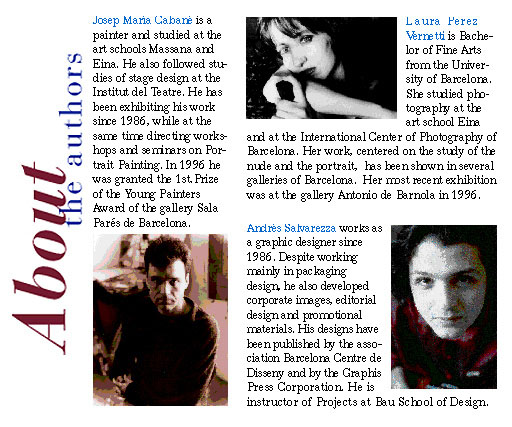
 |
CONTACTS: THE FREAKS |
Guests & Links Mail to Wam |

Aimed at the intrepid websurfer, the freaks proposes a rich discussion between two visions of the portrait: the pictorial and the photographic ones. The pictorial portrait, following the tradition of Beckman and Solana, with brillant and wild colours, even Neopop (according to certain critics) is represented by the painter José Maria Cabané. On the other hand, we find the photographic portrait in the subtle translation to black and white and it's particular treatment of the light created by the artist Laura Perez Vernetti. The painter José Maria Cabané is particulary interested in the portrait of the human figure. The human figure as a "character" that the same painter invents drawing from his inner world. Imagination and chilhood memories deform reality with a transforming will which reminds us, in certain paintings, of a popular gallery of characters, such as the gipsy, the clown or the bullfighter. In this way, the painting represents a scene taken from a thetrical space, where suddenly appears an insolit actor, who sometimes is naïve, sometimes satirical or participating of the world of the pantomime, making a clear reference to the paintings of the Spanish Golden Century, with its jokers and weirdos. In this thetrical space we can glimpse a certain narrative interest, the narrative of a fiction. In this series of portraits, J. M. Cabané tries to confront the dramatic tension of a figure, of a scene that deals, in a transforming and deforming way, with the reality of the human condition. The interweaving and fruitfull clash of the two visual languages, pictorial and photographic, gives way to a third artist who "designs" - Andrés Salvarezza - and directs this chorus of two voices. The person portrayed is a model acting in an imaginary stage. The disguise plays an important role in emphasizing certain features and structures of the subject/object portrayed. The reduced and almost claustrophobic studio of the painter is seen from the perspective of the photographic scenery. Are these characters monstrosities from a side show fair? Are these actors the essence of the painter's personality, lampooned and exaggerated in its most subjective features? Are these men and women adrift in a reality which scapes from the real show as a circus? Are they really playing or suffering? In this sense is remarkable the difference between painter and photographer in their dalogue with the model. The discussion between the painter Cabané and the model is expressed through a bold frontality, a unique, centered and strong presence of the model, even shown through the colour explosion, which conveys at the same time an air of mockery. You would say that the model, in front of a background similar to wall, awaits for the execution to take place, ready to impose his unquestionable presence. However, in the photographic dialogue between Laura Perez Vernetti and the model (the same model within the same space) he seems to be surrounded by a melacholic atmosphere, with a certain abandon and solitude, in a wider and abysmal space, a space with a shimmering light, and in certain cases, in a vision close to horror (as in the picture of the bride holding a candle). The language of black and white stress the sadness and loneliness, and witnesses the behaviuour of these models as if they were unannounced actors in this particular space. Therefore, photography unveils the wandering of the models across this thetrical stage, their performance and their particular reaction in front of the painter who disguises and portrays them, and on the other hand, photography documents, in an artistic way, the intervals, the gestures, the movements, the love-hate relationship, etc., of the scene with a figure. The painting opens an impressive red curtain, which defines in the finished picture, the unquestionable particularity of this human being. The designer Andrés Salvarezza, refined and elegant, collects this puzzle of pictorial and photographic images and melts them in the narration of a third language of the portrait: "Design", so in this way a fourth language: the Web, and a fifth language: WAM magazine, are able to participate in this debate about the portrait. LAURA PEREZ VERNETTI 
|